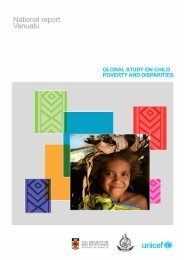A Strategic Assessment of the Children's Services Industry
A Strategic Assessment of the Children's Services Industry
A Strategic Assessment of the Children's Services Industry
- No tags were found...
Create successful ePaper yourself
Turn your PDF publications into a flip-book with our unique Google optimized e-Paper software.
STRATEGIC ASSESSMENT OF THE CHILDREN’S SERVICES INDUSTRYTable 2.4: Long Day Care Staff: Child Ratios by State and TerritoryState/territory Staff : child ratiosNSW 0-2 yrs 1:52-3 yrs 1:83-6 yrs 1:10Vic 0-3 yrs 1:5>3 yrs 1:15Qld 0-2 yrs 1:40-3 yrs 1:52-3 yrs 1:62.5-3 yrs 1:83-6 yrs 1:124-6 yrs 1:13SA 0-2 yrs 1:5>2 yrs 1:8WA 0-24 mths 1:424-36 mths 1:5>36 mths 1:10Tas 0-3 yrs 1:53-5 yrs 1:10>6 yrs 1:15NT 0-3 yrs 1:53-5 yrs 1:11ACT 0-3 yrs 1:5>3 yrs 1:11Source: DEEWR, 2008b: 19Staff trainingRequirements for training among ECEC staff vary widely across jurisdictions. Most states donot require teacher qualifications among long day care centre staff, whereas preschools aregenerally staffed by teachers (Press, 2006: 40). Licensing rules in Victoria require one staffmember qualified with 2 years <strong>of</strong> training for every 15 children, whereas in WesternAustralia, one staff member for each age group is required to have 2-4 years training, and <strong>the</strong>ACT requires every second contact staff member to have 2 years <strong>of</strong> training. Teachers wi<strong>the</strong>arly childhood qualifications are only required in both preschools and long day care in NewSouth Wales.Among workers providing Federal Government approved child care in 2006, 59 per cent <strong>of</strong>staff had formal qualifications in 2004 (SCRGSP, 2008: 3A.13). The proportion <strong>of</strong> staff thathad ei<strong>the</strong>r formal qualifications or three years <strong>of</strong> relevant experience ranged from 78 per centin New South Wales, to 62 per cent in <strong>the</strong> ACT. In preschool services, <strong>the</strong> proportion <strong>of</strong> staffwith relevant qualifications ranged from 69 per cent in <strong>the</strong> Nor<strong>the</strong>rn Territory to 46 per cent inVictoria (SCRGSP, 2005: 14.22).Employment conditionsIn May 2004, nearly all Australian child care workers were women (97 per cent), <strong>the</strong> majority(71 per cent) worked part-time hours and nearly half <strong>of</strong> <strong>the</strong>m held casual jobs that did not<strong>of</strong>fer paid leave for sickness or holidays (Rooney and Whitehouse, 2006: 139). In 2004, <strong>the</strong>average hourly earnings <strong>of</strong> child care workers was $14.90, compared to an average in maleemployment <strong>of</strong> over $20 (for example carpentry and joinery qualified tradespersons earned$23 per hour and unqualified food factory hands earned $21.30) (Rooney and Whitehouse,2006: 140). Such poor working conditions, particularly wage rates, have lead to well-trainedpeople leaving <strong>the</strong> ECEC system (McDonald, 2002: 201). It has been estimated that staffleaving <strong>the</strong>ir positions is <strong>the</strong> cause <strong>of</strong> 50 per cent <strong>of</strong> vacancies which arise among child carestaff and 80 per cent <strong>of</strong> child care coordinators (Press, 2006: 43).12
















